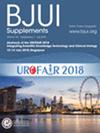The exponential relationship between raised intrarenal pressure and bacteraemia.
IF 4.4
2区 医学
Q1 UROLOGY & NEPHROLOGY
引用次数: 0
Abstract
OBJECTIVE To quantify the amount of irrigation and bacteria that are absorbed into the venous system at various intrarenal pressures (IRPs) during ureterorenoscopy (URS). METHODS We performed in vivo and ex vivo experiments to quantify fluid and bacteria reabsorption during raised IRP. The in vivo models used porcine kidneys of six adult living female pigs under general anaesthesia to simulate URS at serially increased IRPs. For the ex vivo models, porcine kidneys were procured on ice using renal transplant protocols. The renal artery was flushed and perfused with 0.9% normal saline and the renal vein left open to collect continuous venous flow. The ureter was cannulated with a retrograde catheter and the renal pelvis was distended at incrementally greater IRPs using irrigation containing either: (i) 8% acetic acid or (ii) Escherichia coli (E. coli) solution. Venous effluent was sampled every 3 min and tested for: (i) H+ ion concentration or (ii) E. coli colony-forming units per mL. RESULTS Pyelovenous backflow of electrolyte solution and E. coli bacteria was exponentially proportional to IRP. E. coli bacteraemia was present in the venous blood at 30 mmHg IRP in one of six living animals. By 60 mmHg, two animals had bacteraemia, three animals by 75 mmHg, five animals by 90 mmHg IRP, and all six animals by 120 mmHg. The in vitro laboratory studies verified these results and quantified the degree of pyelovenous backflow at each of these pressures. In vitro, increasing IRP from 30 mmHg to 60 mmHg demonstrated a threefold increase in CFU/ml of E. coli. However, increasing IRP by the same magnitude from 60 mmHg to 90 mmHg demonstrated a 60-fold increase in CFU/ml of E. coli bacteraemia, and this continued exponentially up to 200 mmHg. CONCLUSION Pyelovenous backflow increases exponentially after 60 mmHg IRP. Bacteraemia can occur at IRPs between 30 and 120 mmHg in living animals; bacteraemia occurred at an average IRP of 77 mmHg in our study.肾内压升高与菌血症之间的指数关系。
目的量化输尿管镜(URS)术中不同肾内压(IRPs)下静脉系统的灌水量和细菌吸收量。方法采用体内和离体实验定量测定IRP升高过程中液体和细菌的重吸收。体内模型使用全身麻醉下的6头成年母猪肾脏来模拟IRPs连续升高时的URS。对于离体模型,采用肾脏移植方案在冰上获得猪肾脏。冲洗肾动脉,灌注0.9%生理盐水,保持肾静脉开放,收集持续静脉流量。用逆行导管插管输尿管,并使用含有(i) 8%醋酸或(ii)大肠杆菌(E. coli)溶液的灌洗液以逐渐增大的IRPs扩张肾盂。静脉流出液每3 min采样一次,检测:(i) H+离子浓度或(ii)每ml大肠杆菌菌落形成单位。结果电解质溶液和大肠杆菌的脊髓静脉回流与IRP呈指数正比关系。在30 mmHg IRP下,6只活体动物中的1只静脉血中存在大肠杆菌血症。到60毫米汞柱时,2只动物出现菌血症,3只动物出现75毫米汞柱,5只动物出现90毫米汞柱,6只动物全部出现120毫米汞柱。体外实验室研究证实了这些结果,并量化了每种压力下肾盂静脉回流的程度。体外,IRP从30 mmHg增加到60 mmHg,大肠杆菌的CFU/ml增加了三倍。然而,将IRP从60 mmHg增加到90 mmHg时,大肠杆菌菌血症的CFU/ml增加了60倍,这种情况持续到200 mmHg时呈指数增长。结论60mmhg IRP后肾盂静脉回流呈指数增加。在活体动物中,IRPs在30至120 mmHg之间时可发生菌血症;在我们的研究中,细菌血症发生在平均IRP为77 mmHg时。
本文章由计算机程序翻译,如有差异,请以英文原文为准。
求助全文
约1分钟内获得全文
求助全文
来源期刊

BJU International
医学-泌尿学与肾脏学
CiteScore
9.10
自引率
4.40%
发文量
262
审稿时长
1 months
期刊介绍:
BJUI is one of the most highly respected medical journals in the world, with a truly international range of published papers and appeal. Every issue gives invaluable practical information in the form of original articles, reviews, comments, surgical education articles, and translational science articles in the field of urology. BJUI employs topical sections, and is in full colour, making it easier to browse or search for something specific.
 求助内容:
求助内容: 应助结果提醒方式:
应助结果提醒方式:


